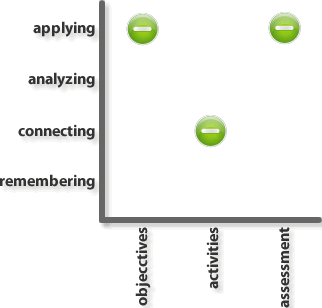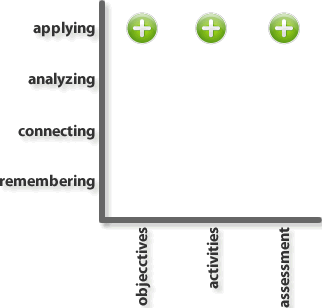Documentation:Building Cohesion Between Goals and Assessment/Learning Module
Introduction

In this module, we will begin to explore the connections between context, course goals, learning activities/objectives and assessment. We'll look at some frameworks and resources for integrated course design, considering a learner-centered approach. Through the use of guiding questions and examples, our focus will be to help you reflect on your own course and consider the issues that you would like to address in order to improve the cohesion between goals, activities and assessment.
Learning Objectives
At the end of this module, you will be able to:
- identify the difference between course goals and learning objectives and learning outcomes.
- map the objectives, learning activities and assessment for a single course learning activity to assess cohesion.
- create a map linking course goals, learning activities, learning objectives and possible learning outcomes and assessment to analyze gaps or missing information.
Readings
- Fink, D. (2003). Integrated Course Design adapted from Creating Significant Learning Experiences. John Wiley and Sons.
- Michigan State University. Virtual University Design and Technology: http://vudat.msu.edu/teach/goals-and-objectives and http://vudat.msu.edu/teach/student-assessment
- Dee Fink's Taxonomy of Significant Learning: http://www.designlearning.org/wp-content/uploads/2010/03/Procedures-for-Assessing-Significant-Learning.pdf
- Landau, V. (2001). Developing Goals and Objectives. Real World Media.
Writing Goals and Objectives
Communicating your goals and objectives for the course will help:
- you select and organize your course content and develop learning activities, instructional strategies and assessments that support your goals.
- your learners direct their learning efforts and monitor their progress.
Learners may also articulate their own goals for the course, which may result in increased motivation and engagement.
Carnegie Mellon University offers an excellent resource on the the value of learning objectives in promoting student learning.
Course Goals
Course goals are broad statements about what learners will have achieved by the end of the course. They are meant to be enduring and will provide the basis for the development of learning objectives, which are more specific and fine-tuned. Using the metaphor of your course as a building, the course goals might be the foundation and the objectives the scaffolding - important to the construction, but not the same as the foundation.
- Example Course Goal: By the end of the course, students will be able to apply fundamental theories in social psychology to real-world situations.
Taxonomies
Taxonomies can be helpful in preparing to write course goals. These may include:
- Bloom's Taxonomy (revised)
- Bloom's Digital Taxonomy - A. Churches
- Dee Fink's Taxonomy of Significant Learning
Well written course goals often have the following characteristics:
- Descriptive and Learner-Centered: "What will learners be able to do, apply, connect, demonstrate as a result of their learning in the course?"
- Measurable (for you or the learner): "How will you (or the learner) know when you have achieved this?"
- Clear and understandable: "Will the learner know what this means?"
- Appropriately general: "Is this an overarching goal appropriate to the completion of the course?"
- Suited to the level of the course
- Leading to authentic, real-world applications.
![]() Reflection
In designing your course goals, it may be helpful to ask yourself "how will students be different as a result of taking this class?" This will help you to focus on the learning (rather than on the topics you want to cover).
Reflection
In designing your course goals, it may be helpful to ask yourself "how will students be different as a result of taking this class?" This will help you to focus on the learning (rather than on the topics you want to cover).
Learning Objectives
Learning objectives are typically related to specific content chunks or course modules. Learning activities typically flow from these objectives.
Writing good learning objectives can be helped with the use of a criteria. The S.M.A.R.T. criteria is often helpful. Using this criteria, learning objectives should be:
- Specific: Tells the learner exactly what is expected.
Example: Learners will analyze a case study, identify the relevant social psychology theories at play,draw out examples from the study to support their answers and present their study to the class during the third week of the course.
- Measurable: How will they and you know when the objective is achieved?
Example: identify theories, draw out examples to support their answers and present to the class. It's also helpful to think of this section of the criteria as motivating. Are the students choosing their own cases based on what interests them - or writing their own if they have an experience to share?
- Action Oriented: Use words in your objective that indicate what learners will do.
Example: identify, draw out, support, present.
- Relevant: Is the objective relevant to the overall course goals? Will it help students get closer to the overall goal?
- Time-bound: It is useful to state exactly when students will need to demonstrate that they have achieved this objective.
Example: during the third week of the course.
Sample Course Goals & Learning Objectives
Carnegie-Mellon's Eberly Teaching Centre: Sample Learning Objectives
![]() Reflection
Goals relate to your destination, objectives are the steps you need to take in order to get there. In planning your course, have you defined the steps that are important for your learner to engage with in order to reach the destination you intend for them?
Reflection
Goals relate to your destination, objectives are the steps you need to take in order to get there. In planning your course, have you defined the steps that are important for your learner to engage with in order to reach the destination you intend for them?
Planning for Assessment
When planning your course activities, keep in mind your goals and how you will assess students' progress. Your course goals must be supported by both the activities and the assessment (ultimately).
In the following example, the objective of the course is to have students be able to apply the course concepts in order to collaboratively solve a problem. However, the activities chosen require the students to classify course concepts and demonstrate a beginning understanding of their connections to the problem they will be required to solve. This means that when students are assessed on their application of all relevant knowledge required to solve the problem, they lack experience with the depth of analysis they need.
The following graph indicates the disconnect between what is assessed and what is practiced.
In an ideal situation, the activities would support the course objectives by ensuring that they require students to engage in such a way that they are building the capacity for success with the final assessment.
In other words, the more clearly you can communicate how the learning activities support the ultimate course goals, the more likely students are to be successful in the assessment.
Building Your Framework
Using the sample table below,
- identify your course goals then consider the steps to getting there (your objectives).
- align your objectives with competency level, specific activities, assessment and possibly identify any supporting tools or technologies that you may want to use.
| Competency Level | Learning Objective | Activity | Assessment | Supporting Tools |
|---|---|---|---|---|
| Analyze/Evaluate Organize/Post/Collaborate Application | Learners will analyze a case study, identify the relevant social psychology theories at play,draw out examples from the study to support their answers and present their study to the class during the third week of the course. | Group case study selection, discussion, identify relevant theories from course readings. Document their findings in a project wiki. | Peer Review / Rubric builder | UBC Wiki - Example of group work using a wiki |
Another resource to help you plan to integrate technology into your course is the SECTIONS Framework. SECTIONS will help you to translate the broadly defined goals you identified above into a plan to identify and integrate the technology required.
Selecting Technology
When selecting technology, it is important to ask yourself what a particular technology allows you to do that you could not otherwise do. How will it change the learning environment in ways that support your learning goals. For example, if you wish to incorporate a blog into your course, you'll want to consider the particular affordances that blogs offer, such as the ability to have learners engage in discussion around particular course themes or topics AND the ability to incorporate sound, video, graphics into the resulting conversation. This also presents an opportunity for learners to both publish their own contributions to the course and offer feedback to their peers as they work towards making sense of and integrating new ideas and perspectives.
As you watch the following video, reflect on the considerations that would be important before implementing a particular technology on your context. Note the link to the supporting pdf.
| Learning Activity | Supports these competencies... | UBC Examples | Suggested assessment methods... | Suggested technology... |
|---|---|---|---|---|
| Collaborative case study development | analysis, remembering, research, process approach to problem solving | GEOG 350: Neighbourhood Project | peer assessment / instructor assessment by rubric | Wiki |
| Collaborative content development | analysis, creation, research, learning and communication in a publishing environment | ETEC 510: Design Wiki | Design_Wiki_FAQ | Wiki |
| Reflective Journals | remembering, analyzing, synthesizing, process approach | PSYC 320: Instructor feedback through voice notation tool to students. Watch course author discuss rationale for using voice tools. | Formative with selection of best 3 for summative assessment | Wimba Voice Tools |
| Learning portfolios | synthesizing ideas and learning across courses | Example: Faculty of Education Portfolios | competency based assessment, developmental assessment, formative assessment by instructor, peer feedback, revision through comments, self-reflection | WordPress MU (UBC Blogs), LMS Block (This will depend on selection) |
| Class survey | metacognition, activating schema, remembering, reflection, evaluation | Example: CWSEI:Videos | data collection over time (Clickers). Formative assessment (peers and instructors) Twitter - more transient | Clickers, Microblog (Twitter) |
| Research Blog | metacognition, activating schema, remembering, reflection, evaluation, writing, synthesizing | Example: ETEC 521 Indigeneity, Technology and EducationCommunicating Science 300 | Summative assessment. Evaluating required posts by each student author. | Author Feeds allow for easy tracking, reading and summary of contributions. |
Your Feedback
Please take a moment to answer a 5 question survey.
|
|

